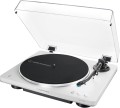Model
Model of the pickup (cartridge) supplied with the player. The pickup is one of the most important parts of any vinyl player, the quality of the received sound largely depends on its quality. Knowing the name of the model, you can find detailed data on it and determine how satisfied you are with this particular cartridge.
Output level
The signal level at the output of the pickup supplied with the player is, in fact, the power of the signal coming from the pickup to the phono stage. This parameter is necessary, first of all, in cases where the player is planned to be connected to an external phono stage: such equipment must be designed for the corresponding power of the signal coming from the pickup.
Downforce
The force of pressing the needle on the plate, which the complete pickup (cartridge) is designed for.
This force depends on the rigidity (compliance) of the needle: the greater the clamping force, the harder the cartridge, respectively, the less pliable it is. It is also believed that less pressing force wears out the record less, but it cannot be said that "light" cartridges are definitely better — there are many other nuances. So in fact, information about the pressing force of a complete pickup is needed mainly in case of its replacement. Usually, the pressing force provided by the arm of the turntable is regulated within these limits, so the new cartridge must also be rated for the same values of downforce — otherwise there is a chance that the turntable will not be able to correctly align.
Tonearm effective length
The effective length of a tonearm in set is the distance from the attachment point (axis of rotation) to the stylus.
This indicator is important primarily for rotary tonearms: the longer the length, the lower the angular error, the smaller the discrepancy between the direction of movement of the track and the longitudinal axis of the pickup (for more details, see “Type”) and the lower the level of corresponding distortion. In addition, a longer length reduces the resonant frequency and reduces the likelihood of distortion. On the other hand, a longer tonearm turns out to be heavier, which requires certain technical tricks and can also negatively affect the purity of the sound. Therefore, a large length is not always a guarantee of high quality – you should also pay attention to weight (see below).
Signal to noise ratio
The ratio between the useful signal and extraneous noise at the output of the player. It is also colloquially called "electrical noise" (although this is not entirely true).
The higher this indicator, the quieter the noise (it is impossible to completely eliminate them), the clearer the signal will be. In the case of turntables, the signal-to-noise ratio is considered to be at least 50 dB; and in the most high-end devices it can exceed 90 dB.
Note that this paragraph may additionally indicate the value of mechanical noise. Despite the similarity in name, this is a completely different indicator — it describes the volume of extraneous sounds produced by the motor, drive and other moving parts of the "turntable". Accordingly, for mechanical noise, the lower the decibels, the better. You can estimate its approximate level using special comparative tables.

